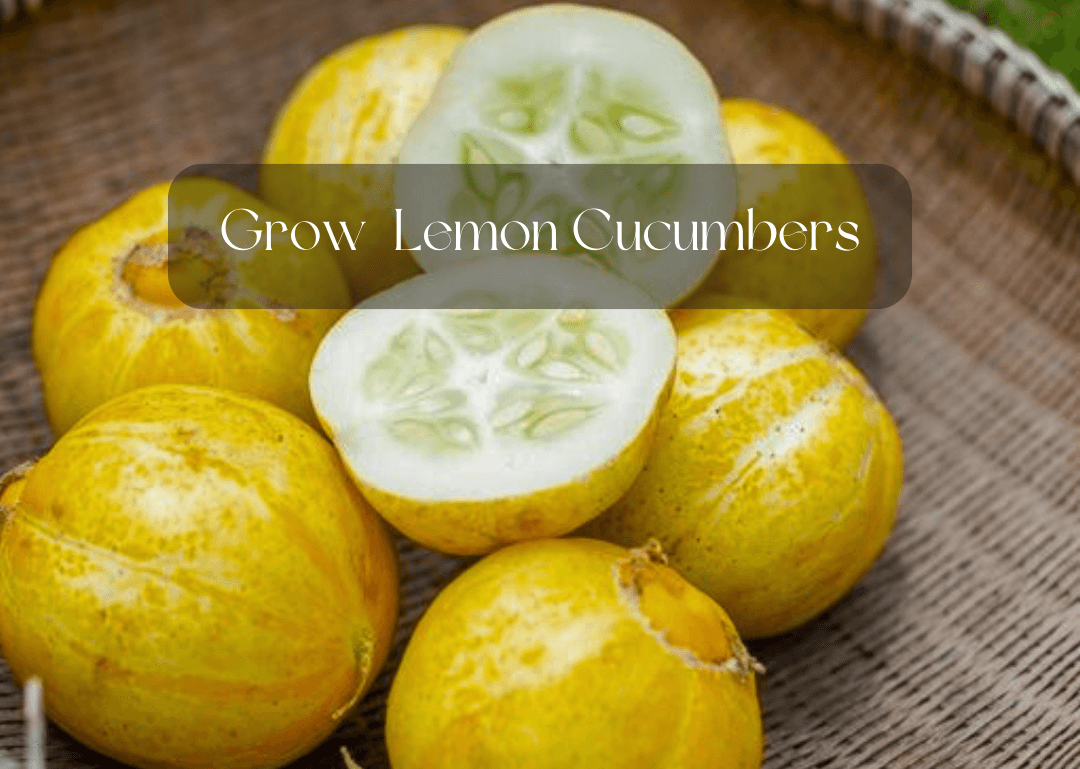
Can You Grow Lemon Cucumbers in a Pot? 2023 Guide
Are you someone who enjoys exploring the delights of cultivating your own fresh produce in your kitchen garden, balcony, or terrace and now thinking about growing Lemon Cucumbers? Are you wondering whether you can grow Lemon Cucumber in a pot? No worries, in this 2023 guide, we’re gonna explore it.
And the best part? You don’t necessarily need a vast garden or sprawling backyard to experience the joy of cultivating these vibrant beauties. Let’s start the amazing journey to growing lemon cucumbers in a pot.
Lemon Cucumbers (Cucumis sativus ‘Lemon’)
Lemon cucumbers; these small, round, and yellow cucumbers with a tangy taste are not citrus fruits but have a sweet and citrusy flavor. They are popular for their versatility in the kitchen and can be used in salads, sandwiches, pickles, and beverages. Lemon cucumbers can be grown in pots, making them suitable for limited garden space or indoor gardening.
How to Germinate Lemon Cucumber Seeds Indoors?
It’s very easy to grow lemon cucumbers in a pot. Start now and let every step bring you closer to an abundance of tangy delights. Follow these 7 steps.
- Collect healthy seeds from a shop or a ripe lemon cucumber
- Make a well-draining potting mix, rich in organic matter.
- Plant the seeds about 1 inch deep, and rinse them with water.
- Keep them on a sunny windowsill or a greenhouse sanctuary.
- Maintain a temperature of around 70 to 85 degrees F (21 to 29° Celcius)
- They will germinate in a week (like 6-9 days)
- Once the seedlings reach a height of a few inches, transplant them

Step-by-step Guide on How to Grow Lemon Cucumbers in a Pot
Select a suitable pot:
Choose a pot that is at least 12×12 inches deep and wide and has holes for good water drainage. Lemon cucumbers have a vigorous root system, so providing enough space for their roots to spread is essential. Make sure the pot is made of a durable material like clay or plastic.
Prepare the potting mix:
Fill the pot with a well-draining potting mix that is rich in organic matter. You can either purchase a quality potting mix from a garden center or create your own mix by combining equal parts of compost, peat moss, and perlite/vermiculite.
Sow the seeds:
Follow the seed germination process above. Plant lemon cucumber seeds about 1 inch deep into the potting mix. Place 2 to 3 seeds in each planting hole, spaced approximately 6 inches apart. This allows enough room for the plants to grow and spread.
Water the seeds:
After sowing the seeds, water the potting mix thoroughly but gently. Ensure that the soil is evenly moist but not waterlogged. Avoid overwatering, as it can lead to fungal diseases and root rot. Maintain the soil moisture by watering the pot regularly, especially during dry periods.
Provide ample sunlight:
Lemon cucumbers thrive in full sun. Place the pot in a location where the plants can receive at least 6 to 8 hours of direct sunlight each day. If growing indoors, choose a sunny windowsill or provide artificial grow lights to supplement sunlight.
Support the plants:
Lemon cucumber vines are vigorous climbers and can sprawl if left unsupported. Install trellises, stakes, or a sturdy wire cage near the pot to provide support for the plants. As the vines grow, gently train them to climb the support structure. This helps keep the fruits off the ground, reducing the risk of rot and pest damage.
Fertilize appropriately:
Start by incorporating a balanced, slow-release fertilizer into the potting mix at the time of planting. As the plants grow, apply a water-soluble fertilizer every two to three weeks during the growing season.
Monitor for pests and diseases:
Keep a close eye on your lemon cucumber plants for any signs of pests or diseases. Common pests that may affect them include aphids, cucumber beetles, and scales. If you notice any issues, promptly treat them using organic or chemical controls to minimize damage.
Perfect Whether to Grow Lemon Cucumbers in a Pot in 2023
Soil Preparation:
The first thing you will need is good-quality soil. Lemon cucumbers are heavy feeders and require well-drained soil that is rich in organic matter, similar to other cucumber varieties. To provide them with extra nutrients, consider adding finished compost or well-rotted manure. Slightly acidic soil with 6.5 to 7.0pH will be great.
Sunlight Requirement:
Lemon cucumbers thrive in full sun, so make sure they receive at least 6 to 8 hours of sunlight per day. Adequate exposure to sunlight ensures robust growth, healthy foliage, and optimal fruit production. By providing them with the recommended amount of sunlight, you’ll set the stage for a flourishing lemon cucumber harvest in your garden.
Enough Watering:
Proper watering is crucial for lemon cucumbers. Use well-draining soil to prevent seed rot and root issues. During the germination phase, keep the soil consistently moist. Once the seedlings emerge, continue watering regularly to encourage flower formation.
Provide about one inch of water per week, ensuring the soil remains evenly moist. In hot and dry weather, you may need to water more frequently to prevent soil from drying out. Avoid overwatering, as it can lead to soggy soil.
Fertilizer and Mulching:
Prior to planting, incorporate compost with phosphorous or use a low-nitrogen 5-10-10 fertilizer. High nitrogen fertilizers may result in excessive foliage growth instead of cucumber production.
Every two weeks, apply an all-purpose fertilizer to nourish the plants. When planting, apply a layer of organic mulch (such as straw or shredded leaves) around the plants.
Mulching helps retain moisture, keep the roots cool, protect against pests, and prevent the cucumbers from directly touching the soil. Avoid excessive mulch, as it can attract slugs.
Temperature and Humidity:
Lemon cucumbers are suitable for cooler climates and require less heat to ripen compared to other cucumber varieties. They generally thrive in temperatures above 60 degrees F and below 90 degrees F. These adaptable plants are less likely to develop a bitter taste even without extreme heat.
By following these guidelines, you can create an optimal environment for your lemon cucumber plants to thrive. They will reward you with a bountiful harvest of delicious and refreshing cucumbers.
Conclusion
In conclusion, growing lemon cucumbers in a pot is not only possible but also a rewarding gardening adventure. With proper care and attention to their sunlight, soil, water, and nutritional needs, you can enjoy the delectable taste of homegrown lemon cucumbers right at your fingertips.
Whether you have limited space or simply prefer container gardening, it has endless ways to grow lemon cucumbers in a pot. Happy gardening and may your pots be filled with bountiful harvests of these lovely fruits!
Some Common FAQs
Let’s explore some common FAQs that often arise when it comes to growing lemon cucumbers.
Why are my Lemon Cucumbers not Producing?
Ans: There could be several reasons why your lemon cucumbers are not producing fruit. It could be due to lack of pollination, improper fertilization, insufficient sunlight, extreme temperatures, watering issues, lack of proper pruning, or pest and disease problems. Assess these factors and make the necessary adjustments to encourage fruit production.
How Long Do Lemon Cucumber Plants Grow?
Ans: Lemon cucumber plants typically have a growth period of around 60 to 70 days from the time of planting to when they are ready for harvest. However, it’s important to note that the exact growth duration can vary depending on factors such as the specific variety of lemon cucumber, environmental conditions, and cultural practices.
What is the Best Spacing for Lemon Cucumbers?
Ans: As a general guideline, it is recommended to space lemon cucumber plants about 12 to 24 inches (30 to 60 centimeters) apart within rows. Rows should be spaced approximately 3 to 6 feet (0.9 to 1.8 meters) apart to allow for adequate air circulation and room for the plants to spread.
Read More from Rose’s Home Garden


